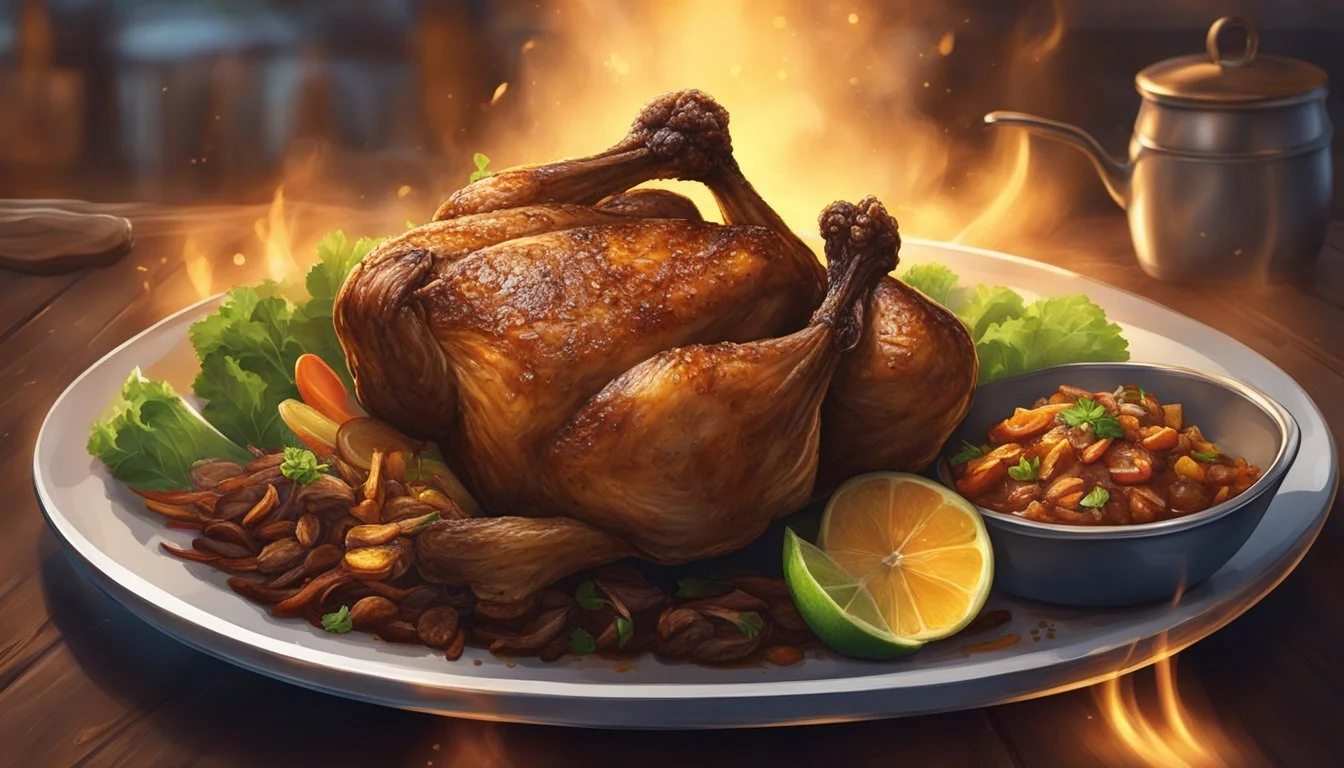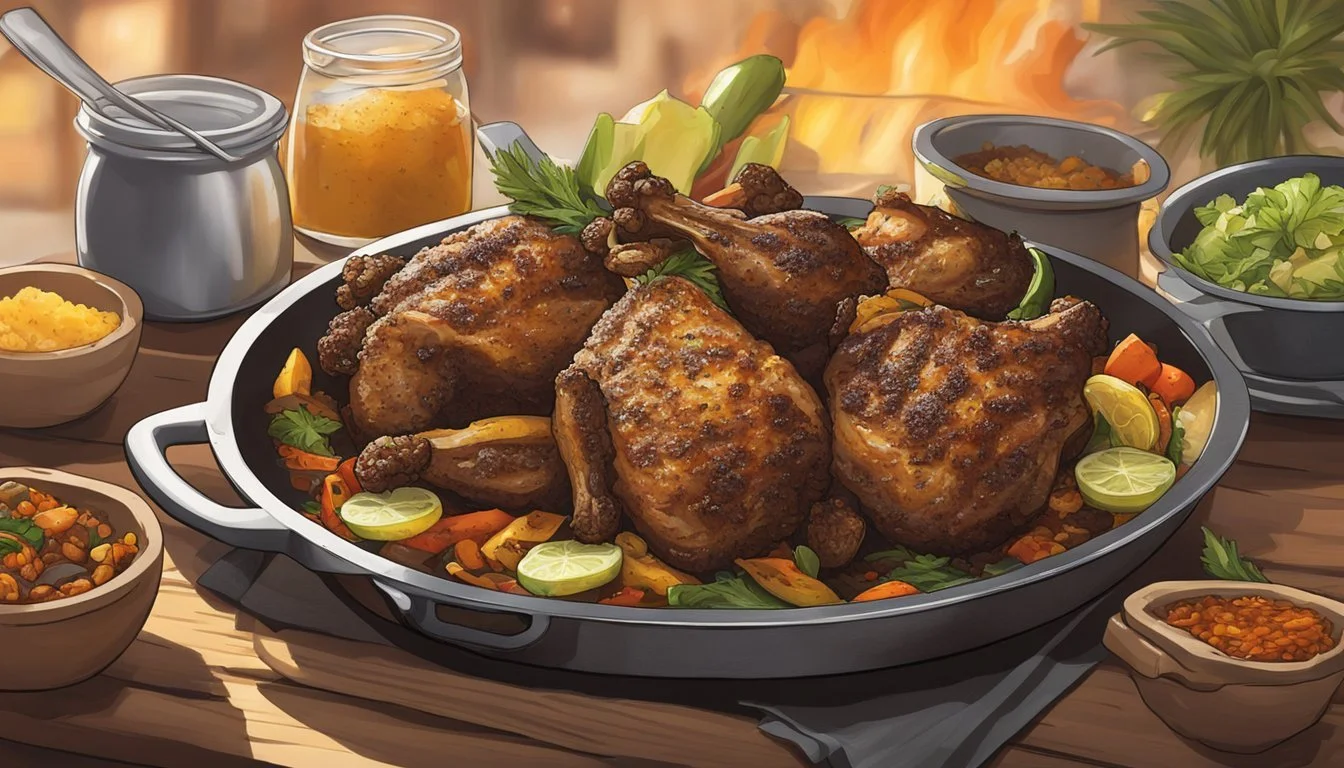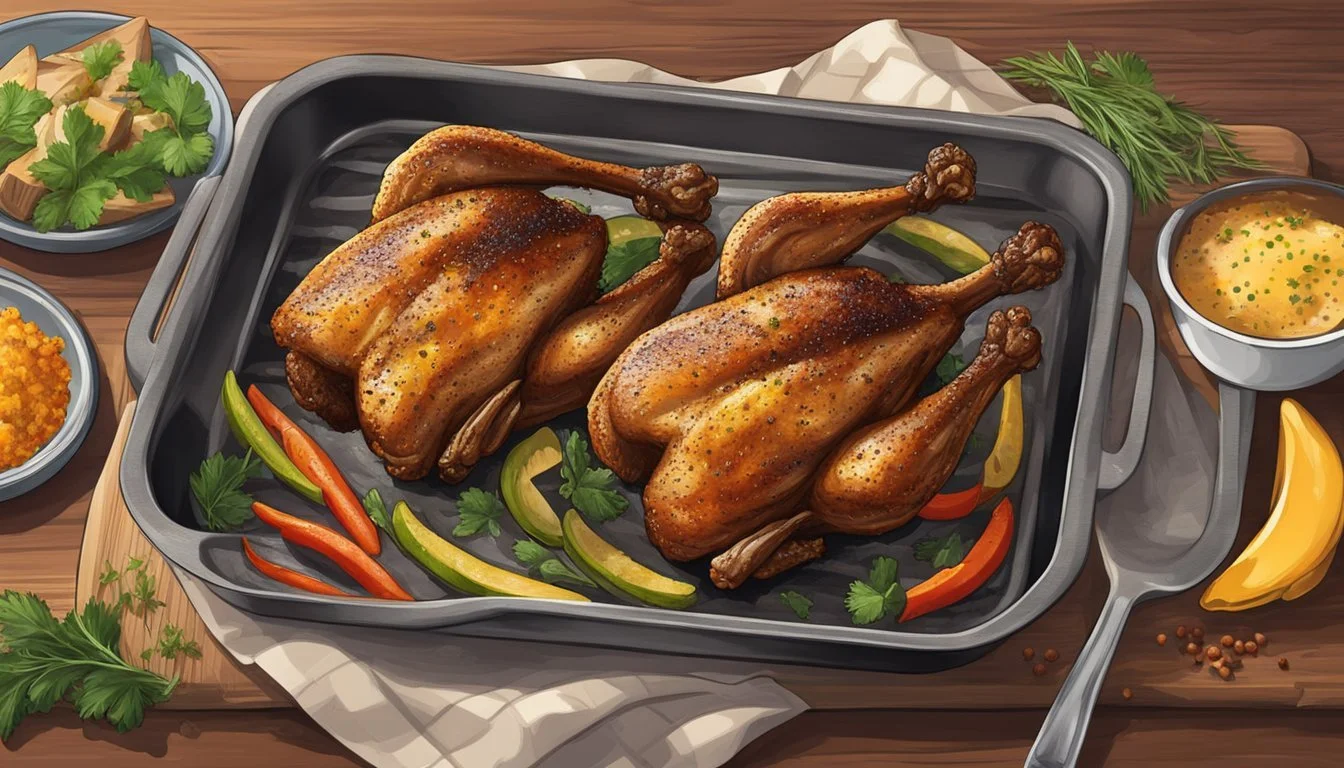Best Way to Reheat Jerk Chicken
Ensuring Spicy Meat and Crispy Skin Every Time
Jerk chicken, known for its robust flavor and smoky, spicy profile, is a culinary delight that presents a unique challenge when reheating. To maintain the distinctively spicy taste and crisp skin, specific reheating methods need to be employed. Ensuring that the meat retains its moisture and tenderness, while also preserving the crispiness of the skin, requires a gentle approach that distributes heat evenly without drying out the chicken.
Oven reheating is a preferred method for many, as it provides a controlled environment for the chicken to warm through without losing its juiciness. Wrapping the chicken in foil with a splash of water or stock can create a steaming effect, preventing the meat from drying out. By additionally uncovering the chicken towards the end of heating and utilizing the broiler for a few minutes, the skin can be crisped up, perfecting the texture.
Alternative ways to achieve similar results include using a stove-top skillet with a bit of water to generate steam, followed by a quick sear to invigorate the skin's crispiness. Regardless of the method, it is crucial to monitor the chicken's internal temperature, ensuring it reaches a safe 165°F (74°C), to enjoy not only flavorful and moist jerk chicken but also food that's safe to consume.
Understanding Jerk Chicken
Jerk chicken, a staple of Jamaican cuisine, is renowned for its fiery flavor and smoky aroma, a result of a unique combination of spices and cooking technique.
History and Origin
Jerk cooking, originating from the indigenous Taíno people of Jamaica, was later expanded upon by escaped African slaves known as the Maroons. They introduced new ingredients and spices to the method, creating what is now known as jerk seasoning. Jerk chicken emerged as a cultural symbol, often associated with strength and resilience, exemplified through its bold flavors.
Key Ingredients and Spices
Marinade: The heart of jerk chicken lies in its marinade, a blend that hinges on two key spices: allspice and Scotch bonnet peppers. Other components typically include thyme, cinnamon, ginger, nutmeg, and green onions. The chicken is marinated for hours, allowing the flavors to penetrate deeply.
Allspice: Ground berries of the Pimenta dioica plant, offering a mix of cinnamon, clove, and nutmeg flavors.
Scotch Bonnet Peppers: Known for their heat and fruity taste, these peppers are central to the spice profile.
The marinade may also contain garlic, brown sugar, and soy sauce to help balance and enhance the flavors.
Health Benefits and Nutrition
While jerk chicken is not always the focal point in discussions of nutrition, it does offer benefits when consumed in moderation. The spices used in jerk seasoning can provide antioxidants and have anti-inflammatory properties.
Nutrition Facts (per serving) Amount Calories 310 Total Fat 14g Protein 30g Carbohydrates 9g
Jerk chicken's protein content makes it a good source for muscle repair, while its spicy nature can aid in metabolism and potentially contribute to weight management. It’s important to consider the sodium content, which can vary depending on the preparation method, so individuals monitoring their salt intake should be mindful.
Preparation Before Reheating
Proper preparation ensures that leftovers, particularly leftover jerk chicken, retain their quality and flavor. The following steps are crucial to prepare jerk chicken for reheating.
Storing Leftover Jerk Chicken
Immediately after serving, it's essential to store leftover jerk chicken correctly to maintain its freshness and safety. Leftovers should be placed in an airtight container and either refrigerated or frozen. If refrigerated, cooked chicken should be consumed within 3-4 days. For longer storage, freezing is recommended. To freeze jerk chicken, wrap it tightly in aluminum foil or cling wrap and place it in a freezer-safe container or bag; this can extend its shelf life for several months.
Thawing and Bringing to Room Temperature
Prior to reheating, if the leftover jerk chicken has been frozen, thawing is a crucial step. It should be thawed safely in the refrigerator, not at room temperature, to prevent the growth of harmful bacteria. Once thawed or if refrigerated, the chicken should then be brought to room temperature for about 20-30 minutes before reheating. This helps in ensuring even heating throughout the meat, aiding in food safety and preserving the jerk chicken's signature spicy kick and crispiness.
Reheating Methods Compared
The following subsections compare different reheating methods for jerk chicken, focusing on the specifics of how each technique preserves the dish’s spicy flavors and achieves a crispy skin.
Oven Reheating
For oven reheating, preheating the oven to 350°F (175°C) is the first step. The jerk chicken should be wrapped in aluminum foil with a tablespoon of water or stock to maintain moisture. It is recommended to heat the chicken for 10-15 minutes, then uncover and broil for 2-3 minutes for a crispy skin.
Stovetop Reheating
Stovetop reheating involves adding a small amount of liquid, such as water or stock, to a skillet and placing over medium heat. Chicken should be heated through to an internal temperature of 165°F (74°C), with stirring or flipping to ensure even reheating. This method is ideal for smaller portions or sliced jerk chicken.
Microwave Techniques
When using microwave techniques, place the jerk chicken on a microwave-safe plate and cover with a damp paper towel. Heat on medium power in increments, checking for an even internal temperature of 165°F (74°C). This method is quick but may not preserve the skin’s crispiness.
Using an Air Fryer
In an air fryer, precook settings should typically be adjusted to 350°F (175°C). The jerk chicken can be placed in the basket, ensuring space for air circulation. It should take about 4-5 minutes to reheat the chicken thoroughly. The air fryer excels at keeping the skin crispy while reheating.
Ensuring Optimal Flavor and Texture
Reheating jerk chicken requires careful balance: one must maximize juiciness and maintain its signature spiciness, while also ensuring the skin achieves optimal crispiness.
Avoiding Dryness and Keeping Juiciness
To prevent the jerk chicken from becoming dry, one should introduce a small amount of moisture when reheating. Adding a tablespoon of water or chicken stock before sealing the chicken with aluminum foil can help maintain a moist environment. When using an oven at 350°F, heat the chicken until it reaches an internal temperature of 165°F to ensure the meat is juicy and safe to eat.
Maintaining Spiciness
The spiciness of jerk chicken is integral to its flavor profile. To preserve this quality, one should avoid reheating methods that could cause the spices to dissipate. The gentle heat of an oven can warm the chicken through without diminishing its spicy kick. If additional moisture is needed, using a stock that complements the jerk seasoning can help enhance the flavor further.
Achieving Crispy Skin
For optimal crispiness, the chicken's skin requires direct exposure to heat. After heating the jerk chicken wrapped in foil, uncover it and place it under a broiler for a few minutes, monitoring closely to ensure the skin crisps without burning. Alternatively, placing the chicken on a wire rack over a baking sheet allows for heat circulation, helping to crisp the skin evenly. On the stovetop, using a skillet over medium-high heat with a touch of oil can also render the skin crispy.
Specific Tips and Techniques
To effectively reheat jerk chicken while maintaining a spicy flavor and crisp skin, the method of reheating is crucial. Below are strategies that emphasize preserving moisture, texture, and safety.
Using Foil and Baking Sheets
Foil: Wrapping the jerk chicken in aluminum foil can help keep the meat moist. Before sealing, a cook might add a tablespoon of chicken stock or broth inside the foil to add extra moisture.
Baking Sheet: Placing the foil-wrapped chicken on a baking sheet ensures even heat distribution. The chicken should be heated at 350°F (180°C) and, for a finishing touch, uncovered in the last few minutes of heating and placed under a broiler to crisp the skin.
Moisture-Locking with Oil and Broths
Olive Oil or Vegetable Oil: A light brush of olive oil or vegetable oil on the chicken before reheating can lock in moisture and aid in crisping the skin.
Chicken Stock/Broth: Adding a small amount of chicken broth or stock when wrapping the jerk chicken in foil, or using it in the base of a pan when reheating on the stove, can enhance flavors and prevent dryness.
Safety and Preventing Bacteria Growth
Temperature Check: Always confirm the chicken has reached an internal temperature of 165°F (74°C) to ensure safety and prevent bacteria growth.
Cooking Spray: To avoid sticking and tearing of the meat, apply cooking spray to the foil or baking sheet. This aids in a clean removal after heating, with the meat intact and skin crispy.
Serving Reheated Jerk Chicken
After properly reheating jerk chicken to ensure the meat is spicy and the skin is crispy, presenting it alongside complementary sides or incorporating it into other dishes elevates the dining experience.
Accompaniments and Side Dishes
For those who enjoy the full flavors of Caribbean cuisine, salad is a refreshing side that balances the heat of jerk chicken. A simple green salad or a more elaborate mango salsa can add a sweet and tangy contrast to the spiciness of the meat. Roasted vegetables, such as bell peppers and onions, also pair well, providing a sweet, smoky flavor that complements the jerk seasoning.
Salad Options:
Green salad
Mango salsa
Vegetable Pairings:
Roasted bell peppers
Grilled onions
Incorporating into Other Meals
The versatility of jerk chicken makes it a delicious addition to various other dishes. For a casual meal, chefs can tuck pieces of the succulent chicken into wraps with fresh greens and a dollop of yogurt or sour cream to temper the heat. Alternatively, jerk chicken can be sliced and stirred into pasta dishes, where its potent flavors infuse the sauce, transforming an ordinary meal into an extraordinary one.
Wrap Combinations:
Jerk chicken strips
Fresh greens
Yogurt or sour cream
Pasta Ideas:
Jerk chicken pieces
Creamy or tomato-based sauces (What wine goes well with tomato-based sauces?)
Troubleshooting Common Reheating Issues
When reheating jerk chicken, one might encounter issues like soggy breading or overly tough meat. This section provides solutions to ensure the chicken retains its spicy flavor and crispiness.
Dealing with Soggy Breading
Soggy breading occurs when moisture is trapped during the reheating process. To prevent this:
Preheat the oven to a moderate temperature, typically 350°F (175°C).
Use an oven-safe dish and cover the chicken lightly with foil.
Remove the foil in the last 2-3 minutes of heating, allowing the breading to crisp.
If reheating in an air fryer, preheat to 360 degrees Fahrenheit and spritz chicken with nonstick spray.
Rescuing Overcooked or Rubber Chicken
Chicken can become rubbery when overcooked. To rescue an overcooked bird:
Reheat gently at a lower temperature to prevent further toughness.
Add moisture by placing a tablespoon of stock or water in the dish with the chicken.
Keep the chicken covered until the final minutes, then uncover to restore crispiness.
Monitor closely, ensuring an internal temperature of 165°F (74°C) to maintain tenderness.
Final Tips and Tricks
When reheating jerk chicken, one should strive to preserve the dish's distinctive spicy taste and achieve a crispy skin. Here are some tips and tricks to ensure optimal results:
Preheating: Always preheat the oven to the recommended temperature, typically 350°F (180°C), for even reheating.
Internal Temperature: Use a meat thermometer to check that the chicken has reached an internal temperature of 165°F (74°C) to ensure it's safe to eat.
Moisture Retention: Add a small amount of liquid, such as water or chicken stock, to the dish before covering it with foil. This creates steam that helps to keep the chicken moist.
Ingredient Purpose Water/Stock Add moisture Foil Retain moisture
Broiler Usage: For crispy skin, remove the foil and place the chicken under the broiler for the last few minutes of reheating.
Wire Rack: Consider reheating the chicken on a wire rack set inside a baking sheet. This allows air to circulate around the chicken, helping to maintain a crispy texture.
Avoiding Plastics: Do not use plastic wrap when reheating jerk chicken, as it can melt and potentially contaminate the food.
Recipe Consistency: To maintain the recipe's integrity, avoid introducing new ingredients that could alter the jerk chicken's intended flavor profile.
Keep these tips in mind to mirror the quality and flavor of freshly-cooked jerk chicken. They are key in achieving not just edible but enjoyable results from leftovers.










